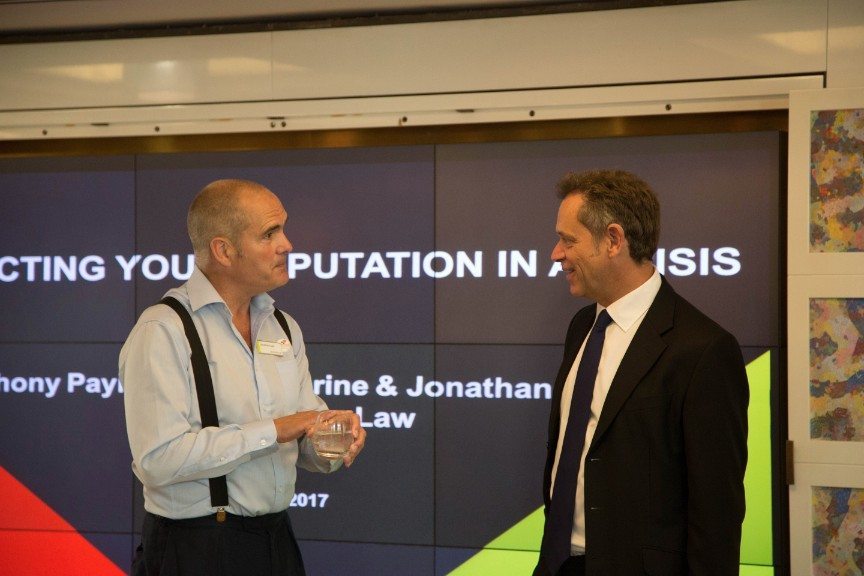Recently media crisis experts Anthony Payne, Chief Executive of Peregrine Communications, and Jonathan Coad, Consultant Solicitor with Keystone Law, hosted a client seminar in central London to discuss reputation protection. They advised firms to establish a few basic rules. What follows is several key take-aways.

Think Defensively
It’s true that many alternative investment fund firms are private companies. Their general partners may feel that media engagement is not for them. This view is understandable. Nevertheless, it’s imperative to work to a plan.
The first step, Payne says, is to do a vulnerability audit. This involves setting up a range of guidelines: don’t post contentious material online, avoid being identified in social media (pictures or video) and be wary of all friend requests.
The importance of p1 Google search results, Payne notes, can’t be overestimated: 92% of readers don’t scroll further.
Payne says it is equally vital to optimise p1 of a Google search. The aim here is to have a Google search optimise owned assets like the firm’s website and shared assets such as LinkedIn. Shared assets should also be created on Twitter, Facebook, Google+ and Glassdoor as well as new content (media clips and video) on other sites with the firm in the headline. The importance of p1 Google search results, Payne notes, can’t be overestimated: 92% of readers don’t scroll further.
The next step in a defensive plan is preparedness. What do you do when the phone rings and its Tyler Durden of ZeroHedge1?! Payne advises getting answers to a few simple questions:
- What type of article is it? News, feature, client or sector focussed?
- When is publication or deadline for comment?
- What sourcing/photographs/footage does the journalist have?
- What does the journalist believe is the public interest in the story?
All of this is designed to establish the key facts: what happened; has it happened before; will it happen again? And, if not, why not? It should allow you to identify the ‘hot button’ issues and whether existing corporate messaging applies. Now you should know enough to decide whether the story is one to work with or one to knock back.

Going on Offence
A seasoned media lawyer like Jonathan Coad can deploy regulatory and legal rights to either kill a story or modify it substantively to reduce potential damage. Since editorial decisions are based on risk assessment, if the media outlet perceives risk to itself, the story will often be softened or dropped.
It’s important to make sure the brand of your firm is not seen as a punching bag – like so many UK financial institutions.
Coad advises that creating this perception should almost always be a part of a firm’s defensive strategy. It’s important to make sure the brand of your firm is not seen as a punching bag – like so many UK financial institutions.
UK regulatory options to stopping the story involve appeals to either the Independent Press Standards Organisation or OFCOM.
Most of the Fleet Street titles belong to IPSO. Its code requires accuracy and provides a remedy for inaccuracy. If a paper believes it is likely to lose an IPSO complaint it is likely to drop the story, Coad says. If a story has run in one paper a prompt IPSO complaint may persuade other media not to run the story.
All UK broadcasters are regulated by OFCOM. Its code requires fairness in factual output and adequate notice of wrongdoing. In many cases a firm will have a day (rather than minutes or a few hours) to deal with a threat to its brand reputation. This time can be often be used to either prevent broadcast or substantially modify the content.

Coad advises that UK legal options to stopping the story generally focus on one or more of four main areas: defamation, malicious falsehood, data protection, and breach of confidence (privacy).
The 2013 Defamation Act makes things harder for claimants, especially companies. A ‘serious harm’ requirement is being defined, Coad says. Publishers have an incentive to publish a prompt apology.
Recourse here is more valuable under the new Defamation Act since there is no requirement of ‘serious harm’. Malice is easier to prove if a publisher has been sent a prior letter establishing the facts. Coad advises using this approach in conjunction with the IPSO Code.
A recent judicial decision allowed the use of a breach of the Data Protection Act to underpin a defamation claim for an individual. The claimant successfully added to a libel claim a DPA claim on the basis that personal data should be processed fairly and lawfully, and that personal data should be accurate.
The law recognises the need to protect confidential business information and private material. With an NDA in place the court is highly likely to grant an injunction unless the media can provide a public interest justification. Small publications will take costs risks seriously.

Getting it right the first time
In managing any story there is a need for speed, multi-disciplinary media and legal teamwork, global monitoring (including social media) and a 24/7 response capability. Getting this framework in place is the key to protecting your firm’s reputation – now and in the future.

1 – Tyler Durden is the nom de plume of several anonymous journalists at zerohedge.com. He is also the fictional character played by Brad Pitt in the movie Fight Club.


